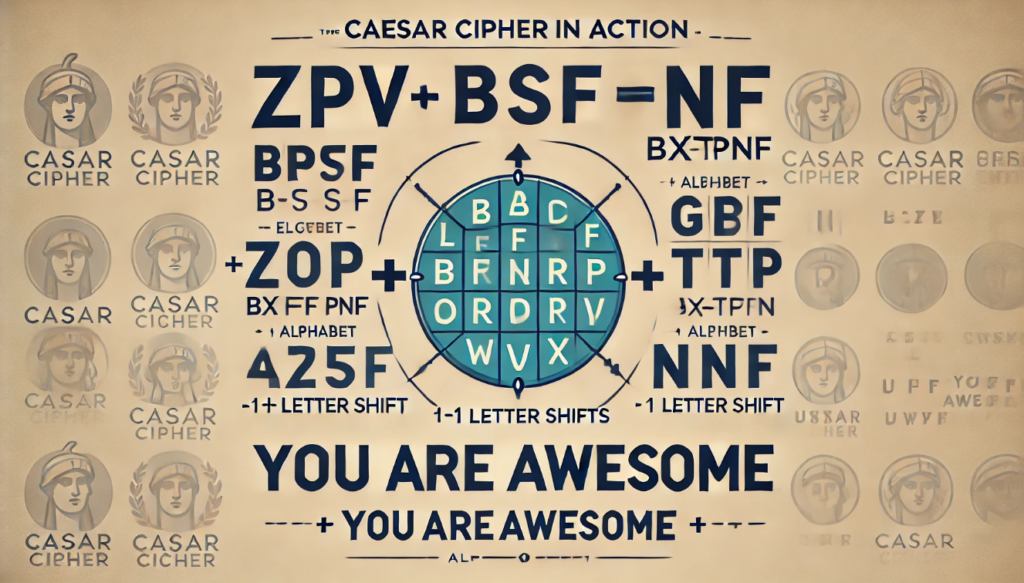Introduction to the Mysterious Phrase
The phrase “zpv bsf bxftpnf” is an intriguing example of a cipher text that sparks curiosity among puzzle enthusiasts and cryptography fans. At first glance, it may look like random gibberish, but with a little knowledge of basic cryptographic techniques, its hidden meaning comes to light. This phrase is encoded using a simple yet iconic encryption method known as the Caesar cipher. Once decoded, it translates to “you are awesome,” a delightful affirmation hidden behind a veil of mystery.
In this guide, we will uncover the mechanics of this cipher, its historical significance, and how you can decode messages like this yourself.
What Is the Caesar Cipher?
The Caesar cipher is one of the earliest and simplest methods of encryption, named after Julius Caesar, who is believed to have used it to protect military communications. It works by shifting each letter in a message by a fixed number of places in the alphabet.
For example, with a shift of 1:
- A becomes B,
- B becomes C,
- And so on.
The process can also work in reverse by shifting letters backward. This simplicity makes the Caesar cipher a favorite for introducing cryptographic principles.
Breaking Down “Zpv Bsf Bxftpnf”
To decode “zpv bsf bxftpnf in words,” let’s break it down step by step:
- Identify the cipher’s rule: The phrase uses a Caesar cipher with a shift of -1, meaning each letter is shifted one place backward.
- Decode each letter individually:
- Z becomes Y
- P becomes O
- V becomes U
- Repeating this process reveals the phrase: “you are awesome.”
Example Table of Encoding and Decoding
| Original Letter | Encoded Letter (-1 Shift) | Decoded Letter (+1 Shift) |
| Y | Z | Y |
| O | P | O |
| U | V | U |
This table illustrates how each letter in the cipher text corresponds to its decoded counterpart.
Understanding Substitution Ciphers
The Caesar cipher is a type of substitution cipher, where each letter in the plaintext is replaced with another letter based on a defined rule. There are two main types of substitution ciphers:
- Simple Substitution Ciphers: These use a fixed system, like the Caesar cipher.
- Polyalphabetic Substitution Ciphers: These vary the system during encoding to increase complexity.
Substitution ciphers are straightforward to understand but also easy to crack, making them ideal for educational purposes rather than secure communication.
Applications of the Caesar Cipher
While the Caesar cipher is no longer used for secure communication due to its simplicity, it has historical and modern applications:
- Historical Use: Julius Caesar and other historical figures used it to encode messages.
- Educational Tool: It helps beginners understand basic cryptographic concepts.
- Entertainment: Puzzle enthusiasts and escape room challenges often feature Caesar cipher puzzles.
How to Decode Caesar Cipher Messages
Decoding a Caesar cipher manually requires knowing the shift value used during encryption. Here’s how you can do it:
- Analyze the text and determine the likely shift based on patterns or hints.
- Shift each letter back by the same number of places in the alphabet.
- Confirm the result by checking if the decoded text makes sense.
If you prefer automation, numerous online tools and software can decode Caesar ciphers instantly.
Importance of Encryption in Modern Times
Encryption has evolved from simple ciphers like the Caesar cipher to sophisticated algorithms used in cybersecurity. Modern encryption methods, such as AES and RSA, protect sensitive information in online communications, banking, and data storage. The Caesar cipher represents the starting point of this fascinating field, highlighting the ingenuity of early cryptography.
Exploring Other Simple Encryption Techniques
If you enjoy decoding the Caesar cipher, here are a few other encryption techniques you can explore:
- Atbash Cipher: Reverses the alphabet to encode messages.
- Pigpen Cipher: Uses symbols instead of letters.
- Reverse Cipher: Simply reverses the text.
Each technique offers a unique way to create and decode secret messages.
Conclusion
Decoding “zpv bsf bxftpnf in words” reveals the hidden affirmation, “you are awesome.” This simple example showcases the ingenuity of the Caesar cipher, an encryption technique that continues to intrigue and educate.
By exploring its mechanics, history, and applications, you’ve taken the first step into the fascinating world of cryptography. Whether you’re solving puzzles or learning about modern encryption, the Caesar cipher provides a fun and accessible starting point.
FAQs for the Topic “Zpv Bsf Bxftpnf in Words”
- Can Caesar cipher messages include numbers and symbols?
Traditional Caesar ciphers are designed for alphabetic text only. However, modern variations can include numbers and symbols by assigning them a sequence or using ASCII codes to shift their values. - How is the Caesar cipher different from a Vigenère cipher?
The Caesar cipher uses a single fixed shift throughout the entire message, while the Vigenère cipher uses a repeating keyword to determine multiple shifts, making it more secure and harder to decode. - What tools can I use to practice decoding Caesar ciphers?
Several online tools, such as cipher decoders, mobile apps, and even programmable scripts in Python, can help you practice encoding and decoding Caesar ciphers. - Is “zpv bsf bxftpnf” the most common example used to explain the Caesar cipher?
While “zpv bsf bxftpnf” is a popular example for educational purposes, other phrases like “khoor zruog” (Hello World) are also widely used for explaining the Caesar cipher. - Can the Caesar cipher be combined with other encryption methods?
Yes, the Caesar cipher can be combined with other techniques, like the Atbash cipher or transposition methods, to create a more complex hybrid encryption system. This combination can increase the difficulty of decryption.
Recommended Articles:
- MHDMaxTV: Your Gateway to Exceptional TV Streaming
- The Exclusive T-Shirt That Says this Edition Is Limited PG23
- Akila Newspaper Today Rajkot: A Comprehensive Overview
- Ultimate Guide to Car Insurance in Clovis Otosigna
- Can a 5800H Do PS4 Emulation and 3060 Mobile? The Complete Guide









































































































Leave a Reply